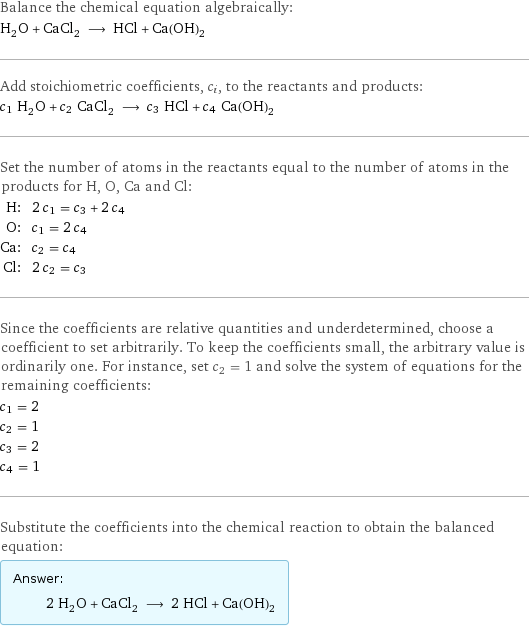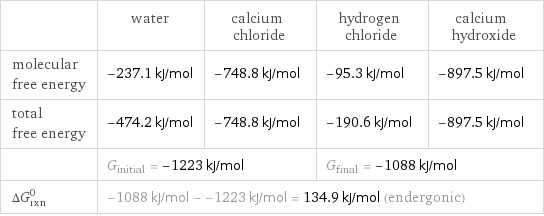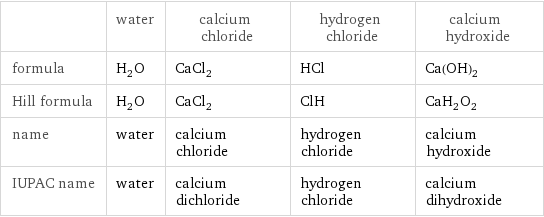Input interpretation

H_2O water + CaCl_2 calcium chloride ⟶ HCl hydrogen chloride + Ca(OH)_2 calcium hydroxide
Balanced equation

Balance the chemical equation algebraically: H_2O + CaCl_2 ⟶ HCl + Ca(OH)_2 Add stoichiometric coefficients, c_i, to the reactants and products: c_1 H_2O + c_2 CaCl_2 ⟶ c_3 HCl + c_4 Ca(OH)_2 Set the number of atoms in the reactants equal to the number of atoms in the products for H, O, Ca and Cl: H: | 2 c_1 = c_3 + 2 c_4 O: | c_1 = 2 c_4 Ca: | c_2 = c_4 Cl: | 2 c_2 = c_3 Since the coefficients are relative quantities and underdetermined, choose a coefficient to set arbitrarily. To keep the coefficients small, the arbitrary value is ordinarily one. For instance, set c_2 = 1 and solve the system of equations for the remaining coefficients: c_1 = 2 c_2 = 1 c_3 = 2 c_4 = 1 Substitute the coefficients into the chemical reaction to obtain the balanced equation: Answer: | | 2 H_2O + CaCl_2 ⟶ 2 HCl + Ca(OH)_2
Structures

+ ⟶ +
Names

water + calcium chloride ⟶ hydrogen chloride + calcium hydroxide
Reaction thermodynamics
Enthalpy

| water | calcium chloride | hydrogen chloride | calcium hydroxide molecular enthalpy | -285.8 kJ/mol | -795.4 kJ/mol | -92.3 kJ/mol | -985.2 kJ/mol total enthalpy | -571.7 kJ/mol | -795.4 kJ/mol | -184.6 kJ/mol | -985.2 kJ/mol | H_initial = -1367 kJ/mol | | H_final = -1170 kJ/mol | ΔH_rxn^0 | -1170 kJ/mol - -1367 kJ/mol = 197.3 kJ/mol (endothermic) | | |
Gibbs free energy

| water | calcium chloride | hydrogen chloride | calcium hydroxide molecular free energy | -237.1 kJ/mol | -748.8 kJ/mol | -95.3 kJ/mol | -897.5 kJ/mol total free energy | -474.2 kJ/mol | -748.8 kJ/mol | -190.6 kJ/mol | -897.5 kJ/mol | G_initial = -1223 kJ/mol | | G_final = -1088 kJ/mol | ΔG_rxn^0 | -1088 kJ/mol - -1223 kJ/mol = 134.9 kJ/mol (endergonic) | | |
Equilibrium constant
![Construct the equilibrium constant, K, expression for: H_2O + CaCl_2 ⟶ HCl + Ca(OH)_2 Plan: • Balance the chemical equation. • Determine the stoichiometric numbers. • Assemble the activity expression for each chemical species. • Use the activity expressions to build the equilibrium constant expression. Write the balanced chemical equation: 2 H_2O + CaCl_2 ⟶ 2 HCl + Ca(OH)_2 Assign stoichiometric numbers, ν_i, using the stoichiometric coefficients, c_i, from the balanced chemical equation in the following manner: ν_i = -c_i for reactants and ν_i = c_i for products: chemical species | c_i | ν_i H_2O | 2 | -2 CaCl_2 | 1 | -1 HCl | 2 | 2 Ca(OH)_2 | 1 | 1 Assemble the activity expressions accounting for the state of matter and ν_i: chemical species | c_i | ν_i | activity expression H_2O | 2 | -2 | ([H2O])^(-2) CaCl_2 | 1 | -1 | ([CaCl2])^(-1) HCl | 2 | 2 | ([HCl])^2 Ca(OH)_2 | 1 | 1 | [Ca(OH)2] The equilibrium constant symbol in the concentration basis is: K_c Mulitply the activity expressions to arrive at the K_c expression: Answer: | | K_c = ([H2O])^(-2) ([CaCl2])^(-1) ([HCl])^2 [Ca(OH)2] = (([HCl])^2 [Ca(OH)2])/(([H2O])^2 [CaCl2])](../image_source/d976a3c83b6615265c29ada51c1d03ec.png)
Construct the equilibrium constant, K, expression for: H_2O + CaCl_2 ⟶ HCl + Ca(OH)_2 Plan: • Balance the chemical equation. • Determine the stoichiometric numbers. • Assemble the activity expression for each chemical species. • Use the activity expressions to build the equilibrium constant expression. Write the balanced chemical equation: 2 H_2O + CaCl_2 ⟶ 2 HCl + Ca(OH)_2 Assign stoichiometric numbers, ν_i, using the stoichiometric coefficients, c_i, from the balanced chemical equation in the following manner: ν_i = -c_i for reactants and ν_i = c_i for products: chemical species | c_i | ν_i H_2O | 2 | -2 CaCl_2 | 1 | -1 HCl | 2 | 2 Ca(OH)_2 | 1 | 1 Assemble the activity expressions accounting for the state of matter and ν_i: chemical species | c_i | ν_i | activity expression H_2O | 2 | -2 | ([H2O])^(-2) CaCl_2 | 1 | -1 | ([CaCl2])^(-1) HCl | 2 | 2 | ([HCl])^2 Ca(OH)_2 | 1 | 1 | [Ca(OH)2] The equilibrium constant symbol in the concentration basis is: K_c Mulitply the activity expressions to arrive at the K_c expression: Answer: | | K_c = ([H2O])^(-2) ([CaCl2])^(-1) ([HCl])^2 [Ca(OH)2] = (([HCl])^2 [Ca(OH)2])/(([H2O])^2 [CaCl2])
Rate of reaction
![Construct the rate of reaction expression for: H_2O + CaCl_2 ⟶ HCl + Ca(OH)_2 Plan: • Balance the chemical equation. • Determine the stoichiometric numbers. • Assemble the rate term for each chemical species. • Write the rate of reaction expression. Write the balanced chemical equation: 2 H_2O + CaCl_2 ⟶ 2 HCl + Ca(OH)_2 Assign stoichiometric numbers, ν_i, using the stoichiometric coefficients, c_i, from the balanced chemical equation in the following manner: ν_i = -c_i for reactants and ν_i = c_i for products: chemical species | c_i | ν_i H_2O | 2 | -2 CaCl_2 | 1 | -1 HCl | 2 | 2 Ca(OH)_2 | 1 | 1 The rate term for each chemical species, B_i, is 1/ν_i(Δ[B_i])/(Δt) where [B_i] is the amount concentration and t is time: chemical species | c_i | ν_i | rate term H_2O | 2 | -2 | -1/2 (Δ[H2O])/(Δt) CaCl_2 | 1 | -1 | -(Δ[CaCl2])/(Δt) HCl | 2 | 2 | 1/2 (Δ[HCl])/(Δt) Ca(OH)_2 | 1 | 1 | (Δ[Ca(OH)2])/(Δt) (for infinitesimal rate of change, replace Δ with d) Set the rate terms equal to each other to arrive at the rate expression: Answer: | | rate = -1/2 (Δ[H2O])/(Δt) = -(Δ[CaCl2])/(Δt) = 1/2 (Δ[HCl])/(Δt) = (Δ[Ca(OH)2])/(Δt) (assuming constant volume and no accumulation of intermediates or side products)](../image_source/decd94158f01c23da7c226183ac8f348.png)
Construct the rate of reaction expression for: H_2O + CaCl_2 ⟶ HCl + Ca(OH)_2 Plan: • Balance the chemical equation. • Determine the stoichiometric numbers. • Assemble the rate term for each chemical species. • Write the rate of reaction expression. Write the balanced chemical equation: 2 H_2O + CaCl_2 ⟶ 2 HCl + Ca(OH)_2 Assign stoichiometric numbers, ν_i, using the stoichiometric coefficients, c_i, from the balanced chemical equation in the following manner: ν_i = -c_i for reactants and ν_i = c_i for products: chemical species | c_i | ν_i H_2O | 2 | -2 CaCl_2 | 1 | -1 HCl | 2 | 2 Ca(OH)_2 | 1 | 1 The rate term for each chemical species, B_i, is 1/ν_i(Δ[B_i])/(Δt) where [B_i] is the amount concentration and t is time: chemical species | c_i | ν_i | rate term H_2O | 2 | -2 | -1/2 (Δ[H2O])/(Δt) CaCl_2 | 1 | -1 | -(Δ[CaCl2])/(Δt) HCl | 2 | 2 | 1/2 (Δ[HCl])/(Δt) Ca(OH)_2 | 1 | 1 | (Δ[Ca(OH)2])/(Δt) (for infinitesimal rate of change, replace Δ with d) Set the rate terms equal to each other to arrive at the rate expression: Answer: | | rate = -1/2 (Δ[H2O])/(Δt) = -(Δ[CaCl2])/(Δt) = 1/2 (Δ[HCl])/(Δt) = (Δ[Ca(OH)2])/(Δt) (assuming constant volume and no accumulation of intermediates or side products)
Chemical names and formulas

| water | calcium chloride | hydrogen chloride | calcium hydroxide formula | H_2O | CaCl_2 | HCl | Ca(OH)_2 Hill formula | H_2O | CaCl_2 | ClH | CaH_2O_2 name | water | calcium chloride | hydrogen chloride | calcium hydroxide IUPAC name | water | calcium dichloride | hydrogen chloride | calcium dihydroxide